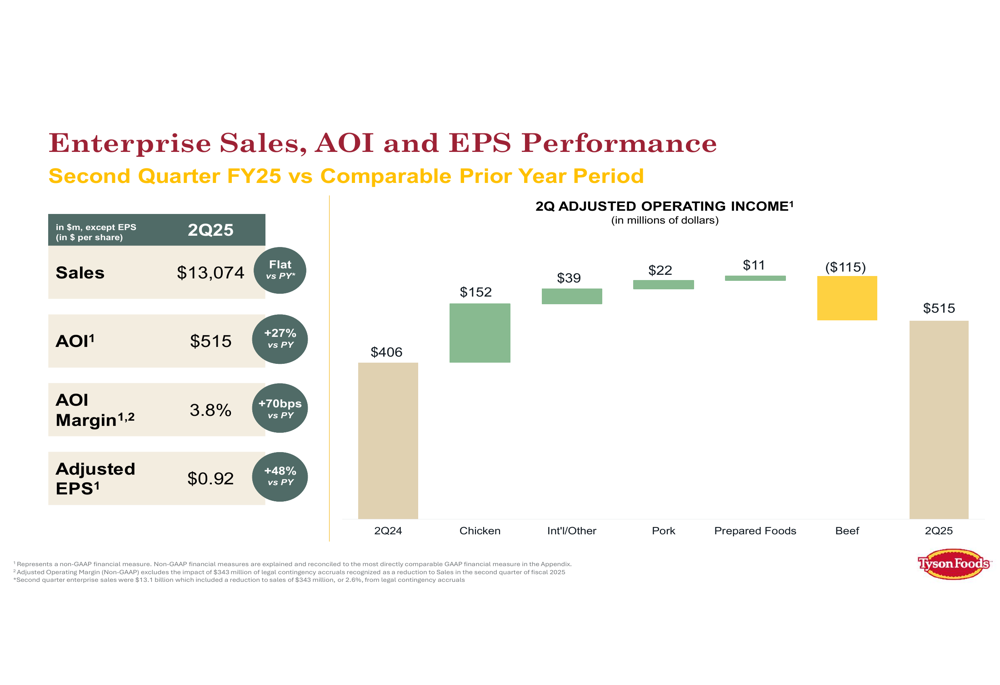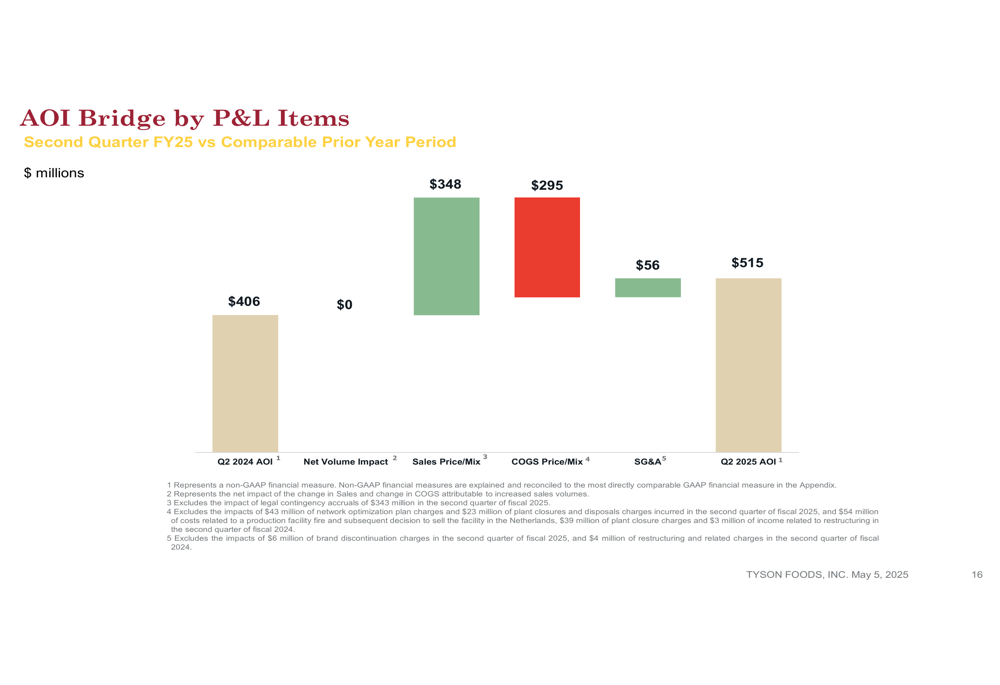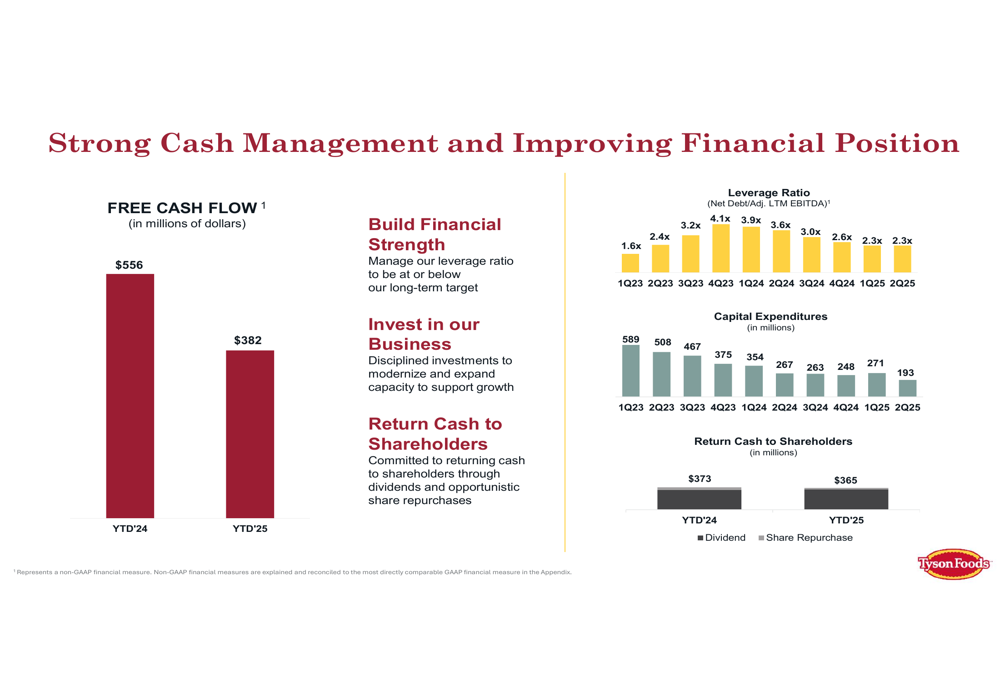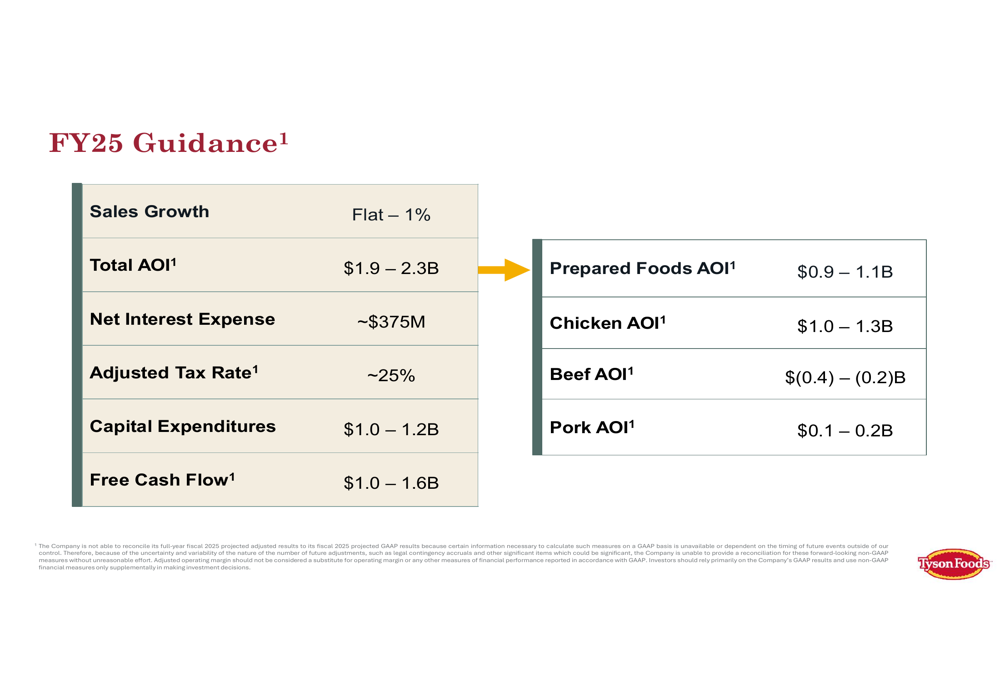Trump administration authorizes CIA for covert action in Venezuela - Bloomberg
Introduction & Market Context
Tyson Foods , Inc. (NYSE:TSN) presented its second quarter fiscal 2025 results on May 5, 2025, highlighting continued operational improvements despite varying performance across its protein segments. The company reported its fourth consecutive quarter of year-over-year growth in sales, adjusted operating income (AOI), and adjusted earnings per share (EPS), demonstrating resilience in a dynamic market environment.
The presentation comes as Tyson’s stock has shown moderate performance, with shares trading at $60.79 at the previous close. However, premarket trading indicated a potential pullback of 2.04%, suggesting investors may have mixed reactions to the results.
Quarterly Performance Highlights
Tyson Foods reported flat sales of $13,074 million compared to the prior year period, while achieving significant improvements in profitability metrics. Adjusted operating income increased by 27% year-over-year to $515 million, with AOI margin expanding by 70 basis points to 3.8%. Adjusted earnings per share saw an even stronger improvement, rising 48% to $0.92.
As shown in the following comprehensive performance chart:

The company’s AOI growth was driven by multiple factors, with a detailed breakdown revealing that positive sales price/mix contributed $348 million, which was partially offset by COGS price/mix impact of -$295 million. SG&A improvements added $56 million to the bottom line, as illustrated in this waterfall chart:

Segment Analysis
Tyson’s performance varied significantly across its protein segments, with Chicken and Pork showing strong improvement while Beef continued to face challenges.
The Chicken segment delivered particularly impressive results with sales of $4,141 million, up 1.9% year-over-year. Volume increased by 3.0% while price decreased by 1.1%. The segment’s AOI nearly doubled year-over-year to $312 million, with AOI margin expanding by 360 basis points to 7.5%. The company highlighted operational improvements and product innovations like Tyson Mega Dino Nuggets and Boneless Chicken Bites as contributors to this strong performance.
The Prepared Foods segment reported solid results with sales of $2,396 million, down slightly by 0.3% year-over-year. Despite a volume decline of 2.6%, price increases of 2.3% helped maintain revenue. AOI increased by $11 million to $244 million, with AOI margin improving by 50 basis points to 10.2%. The company emphasized continued progress on operational excellence and cost management in this segment.
The Beef segment remained challenging, with an operating loss of $149 million despite sales increasing by 4.9% to $5,196 million. The sales growth was driven by price increases of 8.2%, which partially offset a volume decline of 1.4%. AOI margin deteriorated by 210 basis points to -2.8%, reflecting continued tight cattle supply driving compressed spreads.
The Pork segment showed significant improvement in profitability despite sales declining by 16.3% to $1,244 million. Volume decreased by 3.8% while price increased by 4.3%. AOI grew by $22 million to $55 million, with AOI margin expanding by 150 basis points to 3.7%, driven by operational improvements that offset compressed spreads.
Financial Position and Cash Management
Tyson Foods highlighted its strong cash management and improving financial position during the presentation. The company’s net leverage ratio (Net Debt/Adjusted LTM EBITDA) has significantly improved from 4.1x in Q1 2023 to 2.3x in Q2 2025, reflecting a strengthened balance sheet.
The following chart illustrates this positive trend in leverage reduction alongside capital expenditure management:

Free cash flow for the first six months of fiscal 2025 was $382 million, compared to $556 million in the same period of fiscal 2024. This decrease was primarily due to lower cash provided by operating activities ($846 million vs. $1,177 million) and slightly lower capital expenditures ($464 million vs. $621 million).
The company returned $365 million to shareholders year-to-date through dividends and share repurchases, slightly below the $373 million returned in the same period last year, demonstrating its commitment to shareholder returns while maintaining financial flexibility.
FY25 Guidance and Outlook
Tyson Foods maintained its full-year fiscal 2025 guidance, projecting flat to 1% sales growth and total adjusted operating income between $1.9 billion and $2.3 billion. The company expects net interest expense of approximately $375 million, an adjusted tax rate of around 25%, capital expenditures between $1.0 and $1.2 billion, and free cash flow between $1.0 and $1.6 billion.
The detailed segment guidance provides insight into expected performance across the portfolio:

Notably, the Chicken segment is expected to continue its strong performance with projected AOI of $1.0-1.3 billion, while the Beef segment is anticipated to remain challenging with an expected operating loss of $0.2-0.4 billion. The Prepared Foods segment is forecasted to deliver AOI of $0.9-1.1 billion, and the Pork segment is expected to contribute $0.1-0.2 billion.
This guidance aligns with the company’s Q4 2024 earnings call, where management projected a 10% growth in AOI for fiscal 2025, with prepared foods and chicken segments as key contributors to this growth.
Strategic Initiatives
Tyson Foods outlined its enterprise priorities for fiscal 2025, focusing on five key areas:
1. Operational Excellence: Striving for best-in-class operations by gaining efficiencies and eliminating waste, with strong impact already visible in the Prepared Foods segment.
2. Customer & Consumer Obsession: Strengthening iconic brands to expand reach and introducing innovations for new consumption occasions.
3. Data & Digital Delivery: Investing in big data, analytics, and AI to enhance operational decision-making and drive consumer insights.
4. Capital Allocation: Focusing on cash flow by managing capital expenditure and working capital.
5. Team Member Development: Fostering development and encouraging growth to ensure the right talent and skills are in place.
The company emphasized its "controlling the controllables" approach to navigate the dynamic market environment, while noting that consumers continue to view meat as an essential, nutrient-rich option as they prioritize protein in their diets.
Tyson’s multi-protein, multi-channel portfolio strategy appears to be delivering results, with management expressing confidence in their long-term strategy and enterprise priorities summarized by their "One Team. One Tyson" approach.
As Tyson Foods continues to execute on these strategic initiatives, investors will be watching closely to see if the company can maintain its momentum in the Chicken and Prepared Foods segments while addressing the ongoing challenges in the Beef segment.
Full presentation:
This article was generated with the support of AI and reviewed by an editor. For more information see our T&C.
